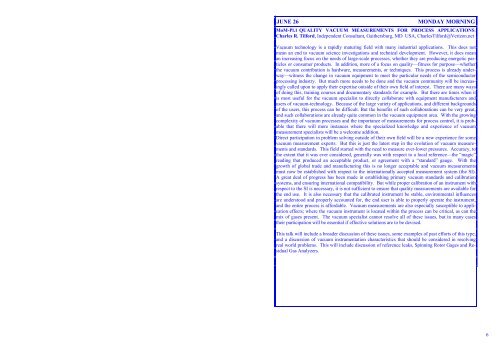Wüest M. 51 Wykes M. 82 Yamaguchi M. 17 Ybarra G. 129 Yubero F ...
Wüest M. 51 Wykes M. 82 Yamaguchi M. 17 Ybarra G. 129 Yubero F ...
Wüest M. 51 Wykes M. 82 Yamaguchi M. 17 Ybarra G. 129 Yubero F ...
Create successful ePaper yourself
Turn your PDF publications into a flip-book with our unique Google optimized e-Paper software.
JUNE 26 MONDAY MORNING<br />
MoM-Pl.1 QUALITY VACUUM MEASUREMENTS FOR PROCESS APPLICATIONS.<br />
Charles R. Tilford, Independent Consultant, Gaithersburg, MD USA, CharlesTilford@Verizon.net<br />
Vacuum technology is a rapidly maturing field with many industrial applications. This does not<br />
mean an end to vacuum science investigations and technical development. However, it does mean<br />
an increasing focus on the needs of large-scale processes, whether they are producing energetic particles<br />
or consumer products. In addition, more of a focus on quality—fitness for purpose—whether<br />
the vacuum contribution is hardware, measurements, or techniques. This process is already underway—witness<br />
the change in vacuum equipment to meet the particular needs of the semiconductor<br />
processing industry. But much more needs to be done and the vacuum community will be increasingly<br />
called upon to apply their expertise outside of their own field of interest. There are many ways<br />
of doing this, training courses and documentary standards for example. But there are times when it<br />
is most useful for the vacuum specialist to directly collaborate with equipment manufacturers and<br />
users of vacuum-technology. Because of the large variety of applications, and different backgrounds<br />
of the users, this process can be difficult. But the benefits of such collaborations can be very great,<br />
and such collaborations are already quite common in the vacuum equipment area. With the growing<br />
complexity of vacuum processes and the importance of measurements for process control, it is probable<br />
that there will more instances where the specialized knowledge and experience of vacuum<br />
measurement specialists will be a welcome addition.<br />
Direct participation in problem solving outside of their own field will be a new experience for some<br />
vacuum measurement experts. But this is just the latest step in the evolution of vacuum measurements<br />
and standards. This field started with the need to measure ever-lower pressures. Accuracy, to<br />
the extent that it was ever considered, generally was with respect to a local reference—the “magic”<br />
reading that produced an acceptable product, or agreement with a “standard” gauge. With the<br />
growth of global trade and manufacturing this is no longer acceptable and vacuum measurements<br />
must now be established with respect to the internationally accepted measurement system (the SI).<br />
A great deal of progress has been made in establishing primary vacuum standards and calibration<br />
systems, and ensuring international compatibility. But while proper calibration of an instrument with<br />
respect to the SI is necessary, it is not sufficient to ensure that quality measurements are available for<br />
the end use. It is also necessary that the calibrated instrument be stable, environmental influences<br />
are understood and properly accounted for, the end user is able to properly operate the instrument,<br />
and the entire process is affordable. Vacuum measurements are also especially susceptible to application<br />
effects; where the vacuum instrument is located within the process can be critical, as can the<br />
mix of gases present. The vacuum specialist cannot resolve all of these issues, but in many cases<br />
their participation will be essential if effective solutions are to be devised.<br />
This talk will include a broader discussion of these issues, some examples of past efforts of this type,<br />
and a discussion of vacuum instrumentation characteristics that should be considered in resolving<br />
real world problems. This will include discussion of reference leaks, Spinning Rotor Gages and Residual<br />
Gas Analyzers.<br />
6
















